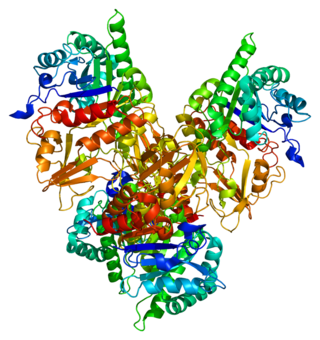
Chitinases are hydrolytic enzymes that break down glycosidic bonds in chitin. They catalyse the following reaction:

Tranylcypromine, sold under the brand name Parnate among others, is a monoamine oxidase inhibitor (MAOI). More specifically, tranylcypromine acts as nonselective and irreversible inhibitor of the enzyme monoamine oxidase (MAO). It is used as an antidepressant and anxiolytic agent in the clinical treatment of mood and anxiety disorders, respectively. It is also effective in the treatment of ADHD.

Conivaptan, sold under the brand name Vaprisol, is a non-peptide inhibitor of the receptor for anti-diuretic hormone, also called vasopressin. It was approved in 2004 for hyponatremia. The compound was discovered by Astellas and marked in 2006. The drug is now marketed by Cumberland Pharmaceuticals, Inc.

Beta-secretase 1, also known as beta-site amyloid precursor protein cleaving enzyme 1, beta-site APP cleaving enzyme 1 (BACE1), membrane-associated aspartic protease 2, memapsin-2, aspartyl protease 2, and ASP2, is an enzyme that in humans is encoded by the BACE1 gene. Expression of BACE1 is observed mainly in neurons and oligodendrocytes.

Insulin regulated aminopeptidase (IRAP) is a protein that in humans is encoded by the leucyl and cystinyl aminopeptidase (LNPEP) gene. IRAP is a type II transmembrane protein which belongs to the oxytocinase subfamily of M1 aminopeptidases, alongside ERAP1 and ERAP2. It is also known as oxytocinase, leucyl and cystinyl aminopeptidase, placental leucine aminopeptidase (P-LAP), cystinyl aminopeptidase (CAP), and vasopressinase. IRAP is expressed in different cell types, mainly located in specialized regulated endosomes that can be recruited to the cell surface upon cell type-specific receptor activation.

The inorganic dye ammoniated ruthenium oxychloride, also known as ruthenium red, is used in histology to stain aldehyde fixed mucopolysaccharides.

Methoxy arachidonyl fluorophosphonate, commonly referred as MAFP, is an irreversible active site-directed enzyme inhibitor that inhibits nearly all serine hydrolases and serine proteases. It inhibits phospholipase A2 and fatty acid amide hydrolase with special potency, displaying IC50 values in the low-nanomolar range. In addition, it binds to the CB1 receptor in rat brain membrane preparations (IC50 = 20 nM), but does not appear to agonize or antagonize the receptor, though some related derivatives do show cannabinoid-like properties.

N-Methylphenethylamine (NMPEA) is a naturally occurring trace amine neuromodulator in humans that is derived from the trace amine, phenethylamine (PEA). It has been detected in human urine and is produced by phenylethanolamine N-methyltransferase with phenethylamine as a substrate, which significantly increases PEA's effects. PEA breaks down into phenylacetaldehyde which is further broken down into phenylacetic acid by monoamine oxidase. When this is inhibited by monoamine oxidase inhibitors, it allows more of the PEA to be metabolized into nymphetamine (NMPEA) and not wasted on the weaker inactive metabolites.
The orexin receptor (also referred to as the hypocretin receptor) is a G-protein-coupled receptor that binds the neuropeptide orexin. There are two variants, OX1 and OX2, each encoded by a different gene (HCRTR1, HCRTR2).

Chitinase-3-like protein 1 (CHI3L1), also known as YKL-40, is a secreted glycoprotein that is approximately 40kDa in size that in humans is encoded by the CHI3L1 gene. The name YKL-40 is derived from the three N-terminal amino acids present on the secreted form and its molecular mass. YKL-40 is expressed and secreted by various cell-types including macrophages, chondrocytes, fibroblast-like synovial cells, vascular smooth muscle cells, and hepatic stellate cells. The biological function of YKL-40 is unclear. It is not known to have a specific receptor. Its pattern of expression is associated with pathogenic processes related to inflammation, extracellular tissue remodeling, fibrosis and solid carcinomas and asthma.

Pravadoline (WIN 48,098) is an anti-inflammatory and analgesic drug with an IC50 of 4.9 μM and a Ki of 2511 nM at CB1, related in structure to nonsteroidal anti-inflammatory drugs (NSAIDs) such as indometacin. It was developed in the 1980s as a new antiinflammatory and prostaglandin synthesis inhibitor, acting through inhibition of the enzyme cyclooxygenase (COX).

Stampidine is an experimental nucleoside reverse transcriptase inhibitor (NRTI) with anti-HIV activity.
Potato carboxypeptidase inhibitor (PCI) is a naturally occurring protease inhibitor peptide in potatoes that can form complexes with several metallo-carboxypeptidases, inhibiting them in a strong competitive way with a Ki in the nanomolar range.a
PCI consists of 39 amino acids forming a 27-residue globular core stabilized by three disulfide bridges and a C-terminal tail with residues 35–39. PCI contains a small cysteine-rich module, called a T-knot scaffold, that is shared by several different protein families, including the EGF family.a
Phoneutria nigriventer toxin-3 is more commonly referred to as PhTx3.
SNX-482 is a toxin from the tarantula Hysterocrates gigas. It acts as a high-affinity blocker of R-type Ca2+ (Cav2.3) channels, but at higher concentrations it can also block other Ca2+ channels and Na+ channels.

Crenolanib besylate is an investigational inhibitor being developed by AROG Pharmaceuticals, LLC. The compound is currently being evaluated for safety and efficacy in clinical trials for various types of cancer, including acute myeloid leukemia (AML), gastrointestinal stromal tumor (GIST), and glioma. Crenolanib is an orally bioavailable benzimidazole that selectively and potently inhibits signaling of wild-type and mutant isoforms of class III receptor tyrosine kinases (RTK) FLT3, PDGFR α, and PDGFR β. Unlike most RTK inhibitors, crenolanib is a type I mutant-specific inhibitor that preferentially binds to phosphorylated active kinases with the ‘DFG in’ conformation motif.

CTEP (Ro4956371) is a research drug developed by Hoffmann-La Roche that acts as a selective allosteric antagonist of the metabotropic glutamate receptor subtype mGluR5, binding with nanomolar affinity and over 1000 times selectivity over all other receptor targets tested. In animal studies it was found to have a high oral bioavailability and a long duration of action, lasting 18 hours after a single dose, giving it considerably improved properties over older mGluR5 antagonists such as MPEP and fenobam.

Photoactivated peptides are modified natural or synthetic peptides whose functions can be activated or controlled using light. These peptides incorporate light-sensitive elements that allow for precise regulation their biological activity in both space and time. The activation can be either irreversible, as in the case of caged peptides with photocleavable protecting groups, or reversible, utilizing molecular photoswitches like azobenzenes or diarylethenes, and diarylethenes By incorporating these light-responsive components into the peptide structure, peptide properties, functions, and biological activities can be manipulated with high precision. This approach enables targeted activation of peptides in specific areas, making photoactivated peptides valuable tools for applications in cancer therapy, drug delivery, and probing molecular interactions in living cells and in organisms.

Martinostat is a histone deacetylase inhibitor (HDACi) that is potent against recombinant class I HDACs and class IIb HDAC with low nanomolar affinities. In tissue CETSA assays, martinostat exhibits selectivity for class I HDACs. When tagged with the radioisotope carbon-11, martinostat can be used to quantify HDAC in the brain and peripheral organs using positron emission tomography. Martinostat was given a name that adopted the style of other HDAC inhibitors, such as vorinostat, entinostat, and crebinostat, that recognized the academic center in which it was developed, the Martinos Center for Biomedical Imaging.
Azemiopsin, a toxin obtained from the Azemiops feae viper venom, is a polypeptide that consists of 21 amino acid residues. It does not contain cysteine residues or disulfide bridges. The polypeptide can block skeletal muscle contraction by blocking nicotinic acetylcholine receptors.















